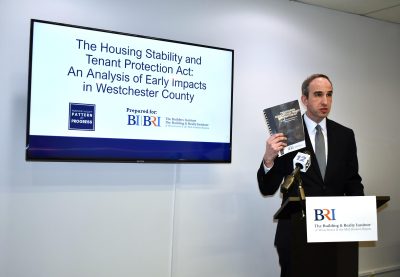Rent Stabilization Law Might Be Bad for Landlords, Tenants: Study
News Based on facts, either observed and verified directly by the reporter, or reported and verified from knowledgeable sources.
A new study released last week suggests that recent state legislation enacted to curtail rent increases on rent-stabilized apartments in Westchester may be having unintended consequences detrimental to property owners and their tenants.
Commissioned by the Building & Realty Institute (BRI), a housing industry trade association, the study was conducted by the nonprofit group Hudson Valley Pattern for Progress to provide an objective and data-driven analysis of how the real estate market has changed since 2019 when the Housing Stability and Tenant Protection Act (HSTPA) went into effect.

The study found an 83 percent decrease in Major Capital Improvement (MCI) applications from 2018, the year before the HSTPA became law, to 2021.
In addition, there has been a marked decrease in money spent by landlords on repairs and maintenance in rent-stabilized apartments, as the allowable rent increases for rent-stabilized buildings in Westchester have not kept up with the rate of inflation.
“Since Albany revised the rent stabilization laws, we’ve heard from numerous property owners that the sweeping changes to the Individual Apartment Improvements and Major Capital Improvement programs had made it financially infeasible to do much more than patch over renovation and repair issues,” BRI CEO Tim Foley said.
“We turned to Hudson Valley Pattern for Progress to provide unbiased, rigorous research and careful analysis to determine whether these were temporary growing pains or the beginning of trends in need of correction,” Foley continued. “We believe their report gives both policymakers and advocates a lot to consider on how we reach our shared goals of providing housing that is affordable, safe, stable, and dignified.”
There are 19 municipalities in Westchester that have adopted tenant protection legislation, including rent-stabilization regulations. Most are in the southern part of the county, but the City of White Plains, the Town of Greenburgh and the villages of Pleasantville, Mount Kisco, Sleepy Hollow and Croton-on-Hudson have rent regulations on the books. While the report did not list the current number of rent-stabilized apartments in Westchester or the breakdown by municipality, there were reportedly more than 26,000 rent-stabilized units in the county in 2018.
The HSTPA curtailed a number of programs allowing property owners with rent-stabilized units to increase rents on new or renewing tenants. The vacancy bonus, which allowed landlords to add a fixed percentage to the rent when there is a change in tenant to help pay for renovations, had been eliminated entirely.
Programs related to Major Capital Improvements (MCIs), like replacing a boiler or renovating an outdated elevator, or Individual Apartment Improvements (IAIs), such as fixing significant wear and tear or replacing outdated appliances or fixtures, were greatly reduced in terms of the money that could be recouped and the period of time that such reimbursements needed to be spread out.
For example, HSTPA changed the maximum allowable rent increase for an MCI-related improvement from 15 percent to 2 percent in Westchester, the report stated.
The report recommends that the state Division of Homes and Community Renewal should make MCI applications, approvals and other data available publicly.
“Our study will allow organizations like the BRI to track those changes over time to make fact-based conclusions about HSTPA and its impacts on renters and building owners,” said Pattern for Progress CEO Adam Bosch.
Bosch conceded that there are some limitations to the study, notably the short amount of time to collect data thus far since HSTPA was adopted in 2019 and the concurrent timing of the law’s passage with the COVID-19 pandemic, which affected tenants, building owners and the economy at large in unprecedented ways.
Hence, Bosch recommends that “these data need to be collected and tracked in future years to understand whether that decrease in applications is an effect of the law, an effect of the COVID-19 pandemic, or a combination of both.”
Generally, multifamily dwellings built between 1947 and 1974, the year of the state’s original rent protection legislation, with at least six units are eligible for regulations. However, some Westchester municipalities have adopted higher unit thresholds for eligibility.

Robert Schork is Examiner Media’s Digital Editorial Director.
